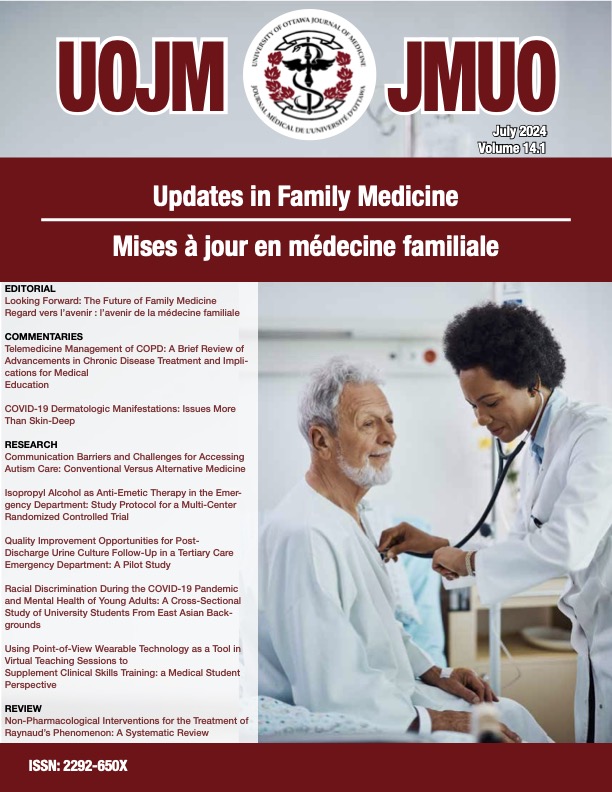Using POV Wearable Technology as a Tool in Virtual Teaching Sessions to Supplement Clinical Skills Training: a Medical Student Perspective
DOI:
https://doi.org/10.18192/uojm.v14i1.6483Keywords:
medical students, medical education, virtual learning, clinical skills, point-of-view, wearable technology, COVID-19Abstract
The COVID-19 pandemic has led to many undergraduate medical programs shifting their preclinical curricula online— reducing access to clinical skills sessions and ultimately causing gaps in students’ knowledge.
This study sought to better understand the impact and role of virtual clinical skills training sessions, using point-of-view (POV) livestreaming wearable technology, in supplementing medical students’ learning.
38 University of Ottawa medical students were recruited to participate in a 1.5-hour virtual clinical teaching session. An abdominal physical examination was broadcasted through two views (chest-mounted smartphone, room overview). Participants completed pre- and post-event questionnaires on their overall impression, satisfaction/challenges, and platform efficacy compared to other learning modalities.
Improvements were noted in participants’ perspectives towards event engagement (p=0.042, Cohen’s d=0.48), comparability to in-person encounters (p=<0.001, Cohen’s d=0.75), and confidence performing a physical exam (p=<0.001, Cohen’s d=1.35). Participants found events were relevant to curriculum objectives (4.55±0.69), engaging and interactive (4.50±0.65), and reported good visualization (4.61±0.59). All participants were interested in attending a subsequent event.
Virtual clinical skill teaching sessions using POV technology were enjoyable and helpful in combating current COVID-related gaps in medical education, adding to the growing literature on the beneficial role of innovative virtual learning opportunities within the medical school curricula. Future research should look to evaluate the use of POV wearable technology in settings beyond the classroom.
Downloads
Published
Issue
Section
License
Copyright (c) 2024 Alicia Sheng, Adam Chubbs-Payne, Ellias Horner, Mariam Issa, Fok-Han Leung, Michael Malek

This work is licensed under a Creative Commons Attribution-NonCommercial-NoDerivatives 4.0 International License.
- Authors publishing in the UOJM retain copyright of their articles, including all the drafts and the final published version in the journal.
- While UOJM does not retain any rights to the articles submitted, by agreeing to publish in UOJM, authors are granting the journal right of first publication and distribution rights of their articles.
- Authors are free to submit their works to other publications, including journals, institutional repositories or books, with an acknowledgment of its initial publication in UOJM.
- Copies of UOJM are distributed both in print and online, and all materials will be publicly available online. The journal holds no legal responsibility as to how these materials will be used by the public.
- Please ensure that all authors, co-authors and investigators have read and agree to these terms.
- Works are licensed under a Creative Commons Attribution-NonCommercial-NoDerivatives 4.0 International License.


